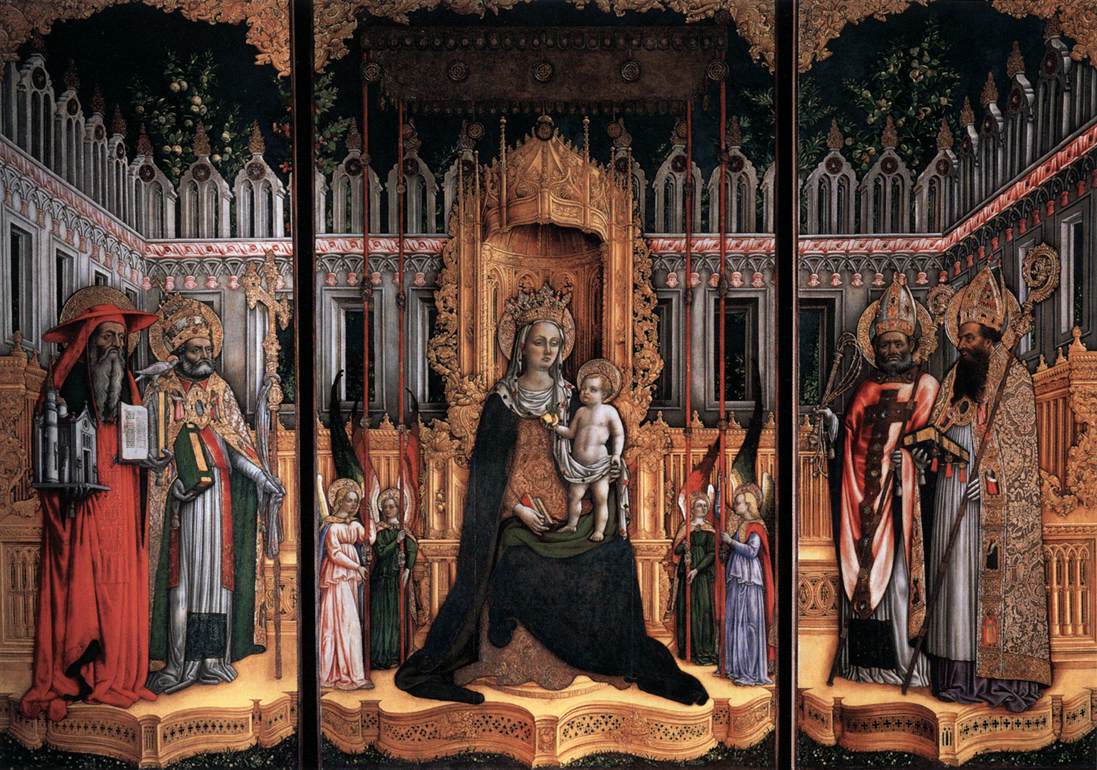Giovanni d'Alemagna on:
[Wikipedia]
[Google]
[Amazon]
Giovanni d'Alemagna (; born Johannes Alamanus; 9 July 1450) was a Venetian renaissance painter of
 He was the tutor of Quirizio da Murano, the exact date is unknown today.
He was the tutor of Quirizio da Murano, the exact date is unknown today.
German
German(s) may refer to:
* Germany (of or related to)
** Germania (historical use)
* Germans, citizens of Germany, people of German ancestry, or native speakers of the German language
** For citizens of Germany, see also German nationality law
**Ge ...
ancestry, active in Italy, with his brother-in-law Antonio Vivarini
Antonio Vivarini (Antonio of Murano) (active c. 14401480) was an Italian painter of the early Renaissance-late Gothic period, who worked mostly in the Republic of Venice. He is probably the earliest of a family of painters, which was descended ...
on religious paintings in Venice and Padua, that are preserved in the named cities together with those of Vivarini.
Biography
Giovanni d'Alemagna is remembered above all for the work done in Venice, characterized by decorative forms that recall Nordic influence. Between 1430 and 1435 he created a cycle called Stories of Christ, which are still exhibited at theCa' d'Oro
The Ca' d'Oro or Palazzo Santa Sofia is a palace on the Grand Canal in Venice, northern Italy. One of the older palaces in the city, its name means "golden house" due to the gilt and polychrome external decorations which once adorned its walls. ...
.
According to Ridolfo and Zanetti, Giovanni and Antonio Vivarini flourished about the year 1440, where they adduce authority for an altar-piece in San Pantalon
The Chiesa di San Pantaleone Martire, known as San Pantalon in the Venetian dialect, is a church in the Dorsoduro ''sestiere'' of Venice, Italy. It is located on the Campo San Pantalon (square), and is dedicated to Saint Pantaleon.
The 17th-centu ...
, which bears the inscription of Zuane e Antonio da Muran pense 1444.
Although it is difficult to distinguish the two artists' contributions, Giovanni is associated with the St Jerome (1444), which carries the signature 'Johannes'. This painting suggests that Giovanni's work was generally flatter and more decorative than Antonio's more naturalistic style.
Giovanni d'Alemagna and Antonio Vivarini ran an shop in Venice that specialized in multi-tiered, multi-paneled altarpieces and fanciful Gothic frames, which they subcontracted to various woodworkers.
Giovanni and Antonio signed and dated the triptych representing the Enthroned Madonna with Child and Saints for the wall behind the officers' bench of the recently expanded meeting room of the Scuola della Carità (now part of the Gallerie dell'Accademia
The Gallerie dell'Accademia is a museum gallery of pre-19th-century art in Venice, northern Italy. It is housed in the Scuola della Carità on the south bank of the Grand Canal, within the sestiere of Dorsoduro. It was originally the gallery o ...
, a result of the collaboration made in 1446 for this room of the hotel. Resembling an altarpiece but functioning as an inducement to good decision making, this monumental painting shows the four doctors of the Church (Sts Gregory and Jerome at the left, Ambrose and Augustine at the right) in a courtyard around a massive Madonna and Child. The Virgin's celestial court is vividly rendered with marbled pink and grey architecture, rich deep colours, costly robes, and lovingly observed plant life.
In 1448, he worked at Vivarini's workshop, which was moved to Padua, together with Andrea Mantegna
Andrea Mantegna (, , ; September 13, 1506) was an Italian painter, a student of Roman archeology, and son-in-law of Jacopo Bellini.
Like other artists of the time, Mantegna experimented with perspective, e.g. by lowering the horizon in orde ...
and Nicolò Pizolo, in the decoration of the Ovetari Chapel
The Ovetari Chapel (Italian: ''Cappella Ovetari'') is a chapel in the right arm of the Church of the Eremitani in Padua. It is renowned for a Renaissance fresco cycle by Andrea Mantegna and others, painted from 1448 to 1457. The cycle was destroyed ...
, but died soon afterwards.
 He was the tutor of Quirizio da Murano, the exact date is unknown today.
He was the tutor of Quirizio da Murano, the exact date is unknown today.
Works
* ''Triptych of Saint Jerome'', Kunsthistorisches Museum,Vienna
en, Viennese
, iso_code = AT-9
, registration_plate = W
, postal_code_type = Postal code
, postal_code =
, timezone = CET
, utc_offset = +1
, timezone_DST ...
* Decorations of the frescoes in the Ovetari chapel, Church of the Eremitani
The Church of the Eremitani (Italian: ''Chiesa degli Eremitani''), or Church of the Hermits, is a former- Augustinian, 13th-century Gothic-style church in Padua, region of the Veneto, Italy. It is also now notable for being adjacent to the Cappell ...
In Venice
*Polyptych
A polyptych ( ; Greek: ''poly-'' "many" and ''ptychē'' "fold") is a painting (usually panel painting) which is divided into sections, or panels. Specifically, a "diptych" is a two-part work of art; a " triptych" is a three-part work; a tetrapt ...
of the Body of Christ "or the Sepulcher", 1433, with Antonio Vivarini, Church of San Zaccaria, Chapel of San Tarasio, Venice
* Polyptych of Saint Sabina, 1443 and Polyptych of the Virgin with Antonio Vivarini, San Zaccaria Church, San Tarasio chapel
* Coronation of the Virgin, 1444 with Antonio Vivarini, Church of San Pantalon, Venice
* Triptych of the Virgin and child in majesty surrounded by angels between the doctors of the Church (saints Gregory, Jerome, Ambroise and Augustine, 1446, with Antonio Vivarini, tempera on panels, central 339cm × 200cm and two sides of 339cm × 138cm each, Gallerie dell'Accademia de Venise, Venice.
Notes
References
Bibliography
* * * * * * * * * * *Further reading
* Ian Holgate, ''Artibus et Historiae'', Vol. 24, No. 47 (2003), pp.929External links
{{DEFAULTSORT:Alemagna, Giovanni d 1411 births 1450 deaths 15th-century German painters German male painters 15th-century Italian painters Italian male painters Year of birth uncertain